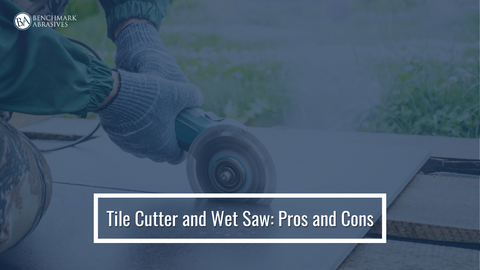
Tile Cutter and Wet Saw: Pros and Cons

Are you getting ready to replace the counter in your kitchen? Are you changing the floor in your bathroom? Whatever your home improvement project's scope, you must consider the tools and materials you will require. Porcelain tile cutting doesn't have to be stressful. By adhering to these tile cutter best practices and selecting expert tiling tools, you can achieve excellent results, even if you are a beginner at setting tiles.
Tile cutters and wet saws are the two main cutting instruments you require while dealing with tiles. Although these two cutting tools are excellent for DIYers, which one is ideal for your particular task? Learn about the advantages and disadvantages of each tool in our guide to selecting the best one for your project.
THINGS TO CONSIDER BEFORE SELECTING A TILE CUTTER OR WET SAW
COMPOSITION OF TILES
There are various tiles, including ceramic, clay, porcelain, stone, and more, but the first three are the most typical. Sand, water, and clay are the ingredients of ceramics. More dense clay is used to make porcelain. 100% clay is used to make ceramic tiles. These tile options are often unglazed for roofing, outdoor tiles, or indoor purposes. The sort of cutting tool you require will depend on the composition of the tile.
FLOOR PLAN MEASUREMENT
Your floor plan describes how tiles will be laid out. Every room or space has a different spatial demand, so measuring the floor plan will help you choose the proper amount of tile and buy enough supplies to finish the task. It is crucial to measure precisely. Measure the perimeter, diagonal interiors, width, and floor height. Next, quantify a square of the example tile. Calculate how many tiles you'll need for your project using these numbers. Be sure to consider anomalous boundaries as well.
TILE CUTTING
You won't always be working in a precisely square room that can accommodate multiples of your chosen tile shape. Most of these tile projects include cutting tiles, a necessary step in the process. Tile cutters and wet saws are the two essential cutting tools. The appropriate tool is determined by several variables, including the project's size, tile type, user skill, and more. Here are the advantages and disadvantages of tile cutters and wet saws and what you need to know about each choice.
TILE CUTTER
Tile cutters are hand-operated devices that cut tiles by placing them inside and scoring them. These tiles are then ready to be fitted after breaking along the scoring line.
PROS AND CONS OF TILE CUTTER
PROS -
- Less expensive than wet saws.
- Portable.
- Operation doesn't require expert knowledge.
- Excellent for straight borders, soft tiles, and small projects.
CONS -
- Tile cutters perform poorly when cutting hard tiles.
- Not suitable for use on glass tiles.
- Tile breaking along the score can be difficult.
- To get it properly, it could take a few tries.
WET SAW
Larger tasks and hard tiles are perfect uses for wet saws. In order to give the operator more comfort and reduce the need for human power, they operate by utilizing electricity. The diamond saw blades are powerful and hard enough to cut even the thickest tiles.
PROS AND CONS OF WET SAW
used in wet saws, and a guide maintains the straightness of the tile cuts.
PROS:
- Contains a template for cutting straight tiles.
- Tiles can be skillfully carved into complex forms.
- Capable of producing curved tiles.
- Tougher tile materials can be cut.
- Perfect for big projects.
- Swift performance.
CONS:
- Not portable, large apparatus.
- The units are big.
- Learn how to utilize it takes time.
- Greater risk to safety.
- Greater cost.
As you start planning and getting ready for your tiling project, these tile cutter and wet saw best practices and information should help you get on the right track.



































































